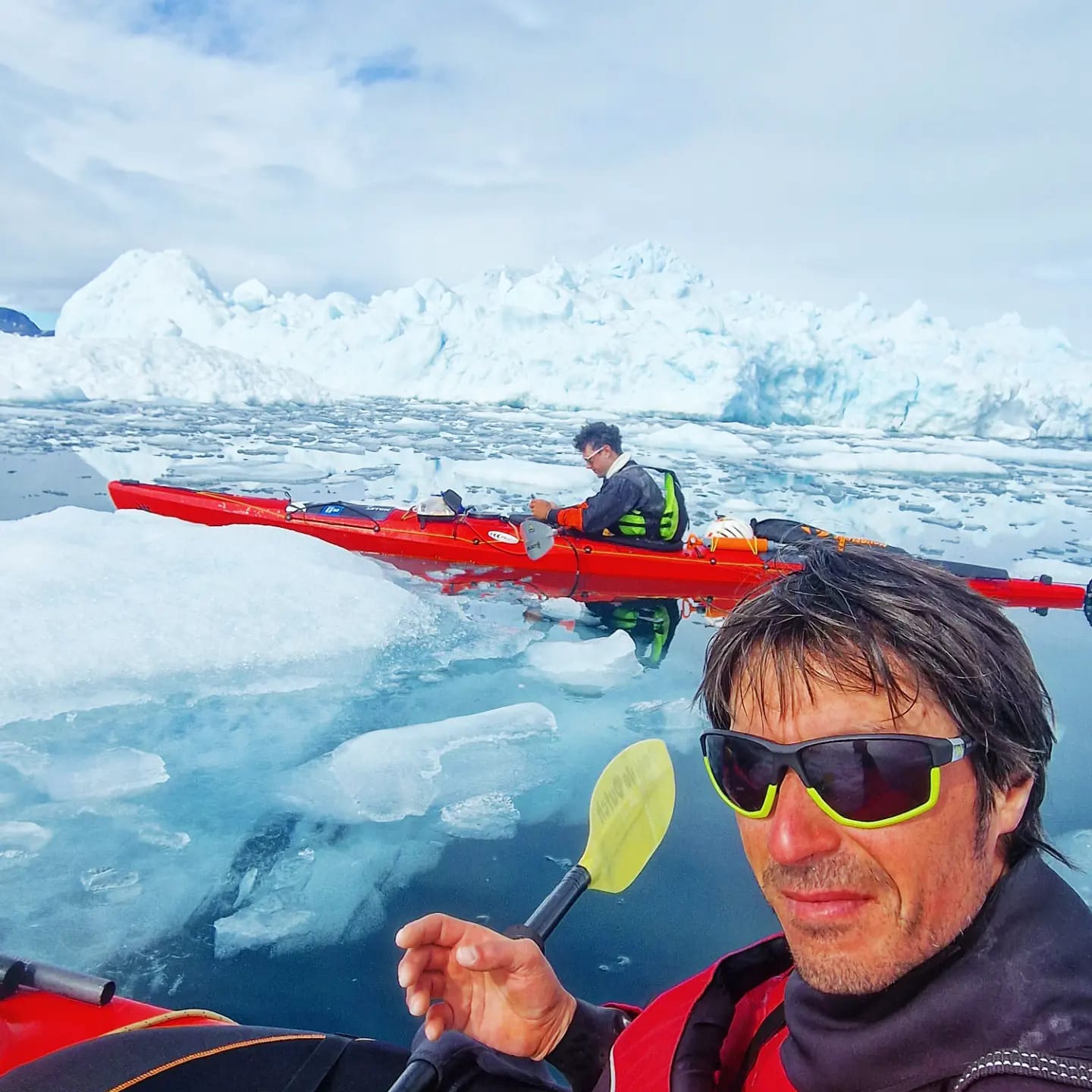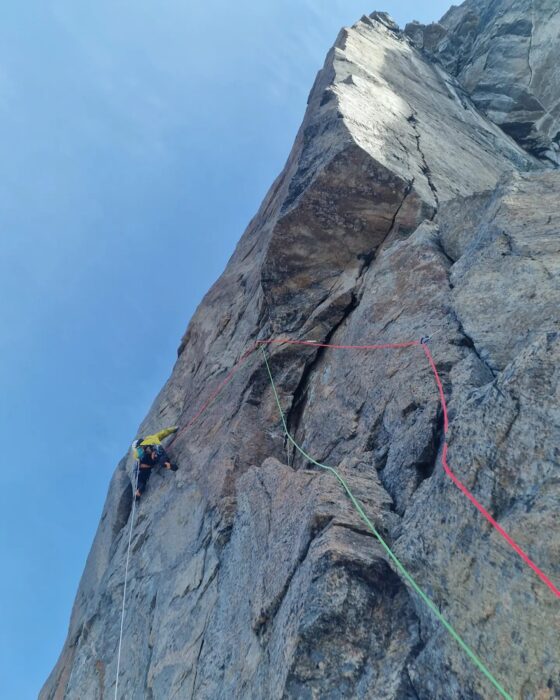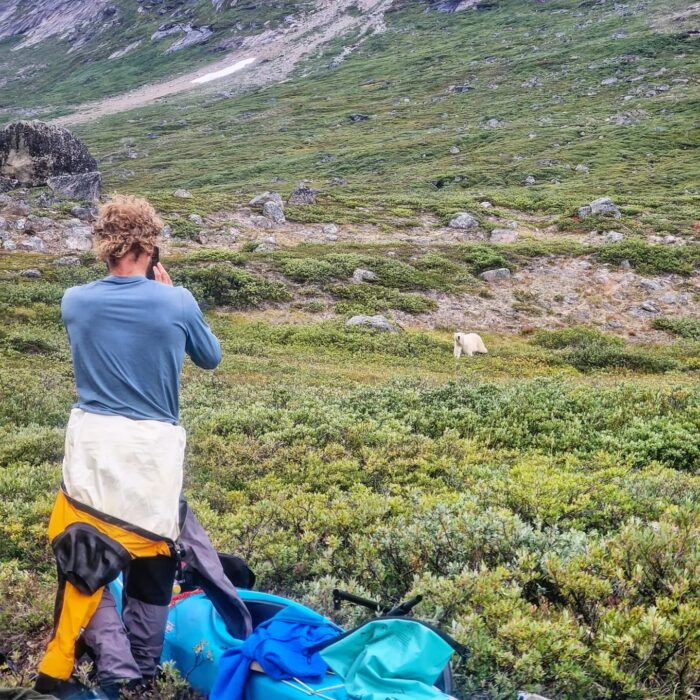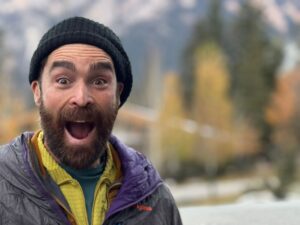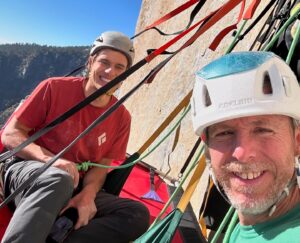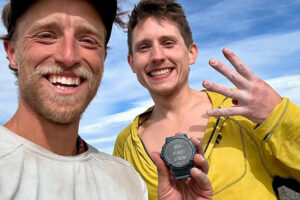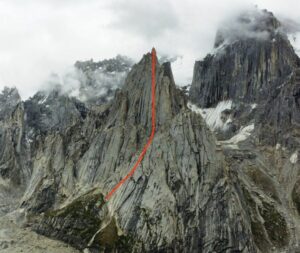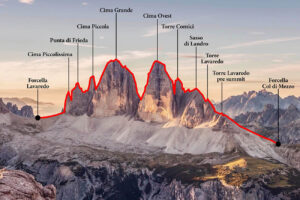This past summer, Matteo Della Bordella, Symon Welfringer, Silvan Schupbach, and Alex Gammeter made the first ascent of a remote 1,980m wall in East Greenland. But their climb of the northwest face of Droneren was only part of the adventure.
They spent 33 days in the Arctic, kayaked 450km, then climbed 35 pitches on a wall with difficulties up to 7b in pure trad style. They had four encounters with polar bears. Finally, they put together a film that is now screening at mountain film festivals. (Next viewing is at Courmayeur on December 13.) A busy month.
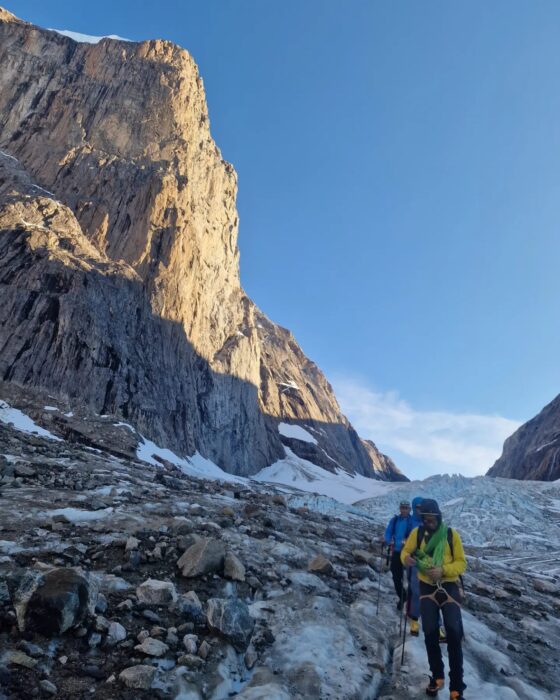
The northwest face of Droneren. Photo: Matteo Della Bordella
We spoke to Matteo Della Bordella about his thoughts on the expedition. He also shared a report that partner Simon Welfringer wrote in English.
Raising the bar
Della Bordella has kayaked and climbed in Greenland before, but always within a fiord. This involved the open sea and was his biggest challenge yet.
“It raised the bar in many ways,” he said. “Most of all, because the place was so remote and so far. For the first time, I really felt in the middle of nowhere.”
The face was challenging in part because of rock conditions and the time pressure. They had limited supplies, so every day they spent kayaking or climbing meant one day less food to get back.
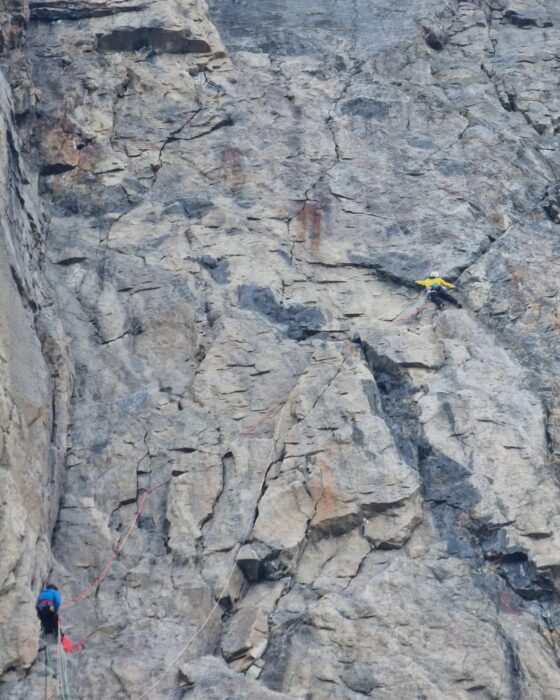
The face. Photo: Matteo Della Bordella
Half climbing, half kayaking
The team arrived at Tasiilaq in East Greenland in mid-July, but thick pack ice delayed their start. This was a rough ice year on the east coast of Greenland. When a piteraq, a katabatic wind blowing down from the Ice Sheet, momentarily cleared the way, the foursome paddled 300km south in 10 days to Skjoldungen Fiord. (They had received a partial lift via boat to a hunter’s hut 150km from Tasiilaq.)
“We took everything with us: food and gas for the entire expedition, [plus] the climbing and camping gear,” Della Bordella told ExplorersWeb. “[This] increased the uncertainty of success.”
To do otherwise, they felt, would have been easier but less adventurous.
In fact, the climbing took only 15 out of the 33 days, not counting the boat transfers. They spent eight days kayaking to the wall and another four kayaking back to their pickup. They waited out storms for the other six days.
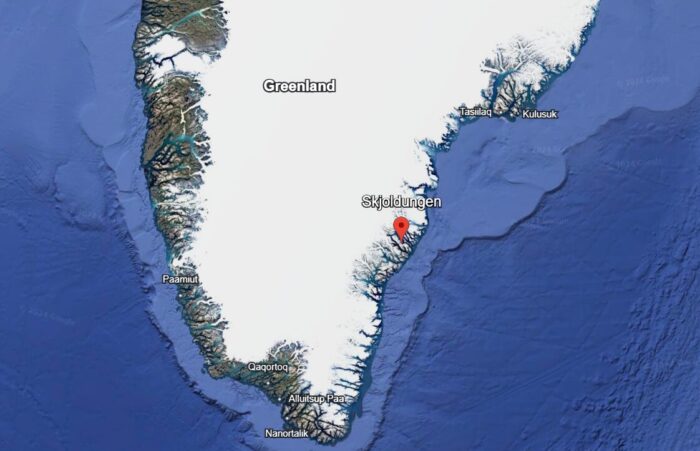
Skjoldungen is 300km south of the nearest human settlement. Map: Google Earth
Kayaking amid the ice floes
According to Welfringer, they faced obstacles every day at sea. “Once, we got stuck in the ice and narrowly escaped. Another time, we were almost crushed by ice floes as the tide changed.”
Then a storm forced them to stay in their fragile tent for 60 hours as the violent wind sent rocks flying through the air.

Paddling amid bergy bits and sea ice. Photo: Matteo Della Bordella
“I especially recall the amount of ice at the beginning,” Della Bordella said. “There were moments when we had to paddle among so many icebergs and chunks of moving ice…it was like trying to cross a highway with heavy traffic.”
He also recalls some scary moments with swells up to three meters high.
Skjoldungen Fiord
The team set up base camp in Skjoldungen Fiord and went for the northwest face of Droneren, a spire that American adventurer Mike Libecki first spotted and attempted some years ago. No other teams had been there since Libecki.
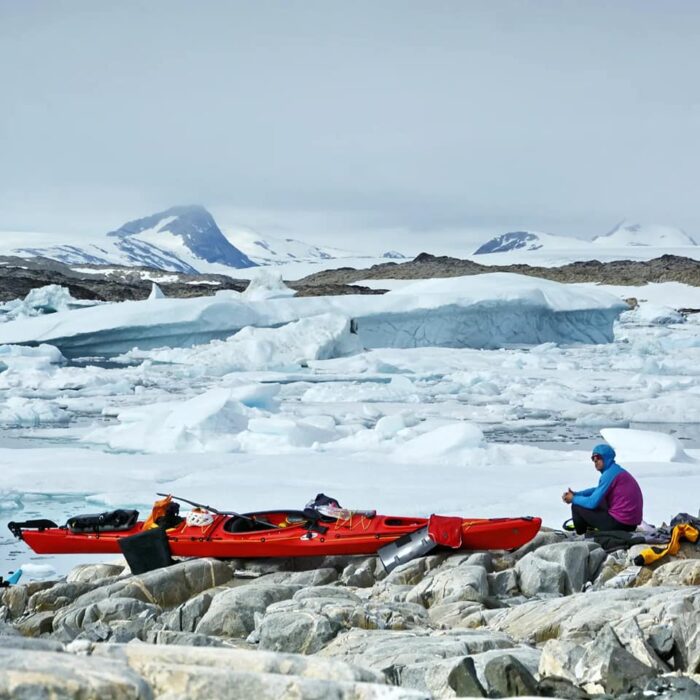
A brief rest stop along the way. Photo: Matteo Della Bordella
“The approach through the flat valley floor had a special charm, struggling naked through rivers and swamps, stung by thousands of sand flies,” Welfringer recalled. “Further up, we climbed over moraines and firn fields to the glacier below the wall. Shortly after our arrival, as if to welcome us, a huge boulder fell out of the left part of the wall and crashed spectacularly…After this, we quickly agreed to stick to the central pillar in the middle of the wall when climbing.”
The climb
They climbed capsule style, working on the lower sections of the wall during the short, drier weather in between the otherwise relentless rains. The weather thwarted three summit pushes. In the end, they had to sacrifice style on their return and shorten the kayaking in order to gain more time for the climb. It paid off.
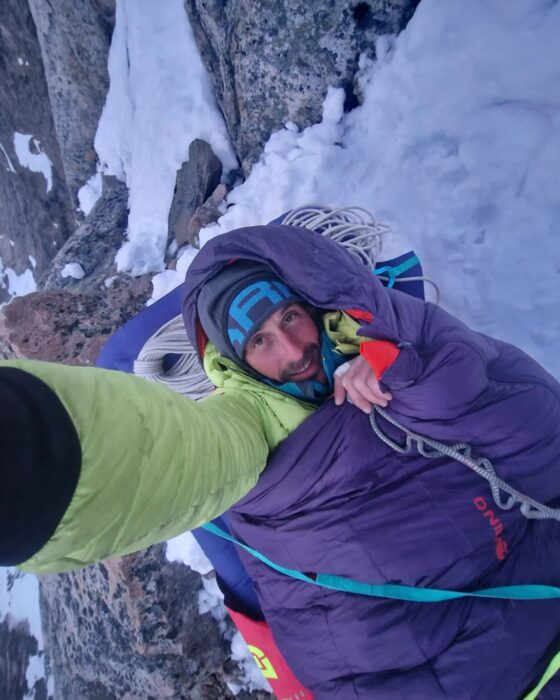
From the hammock. Photo: Matteo Della Bordella
It was on our fourth attempt, at the last minute so to speak, that we finally reached the end of the fixed ropes again. Symon and Matteo climbed quickly into the new terrain. Alex and I carried all the gear. It was great to finally be on the wall and give it our best shot! Late in the evening, we reached a good bivouac spot high up on the wall.
Photo: Matteo Della Bordella
The mood was finally good, and motivation was high. The next day, Alex and I climbed ahead. It was cold, and the higher we got, the more snow there was on the wall. Alex climbed some combined pitches, without crampons and ice axe. After the magnificent last pitch, we left the rocks below us and stood in front of the impressive summit ice cap. A hundred meters later, we finally reached the summit.
They free-climbed the entire route, says Della Bordella, without bolts.
Not over yet
Back down, the team had more adventure than expected. There was no boat immediately available to bring them back to town, so they again loaded the kayaks and started paddling. They had just four days of food and assumed they would have to kayak at least half the way back.
Just as we were getting into the kayaks, a polar bear appeared right behind us. It was very curious, and we were alarmed. I took out my rifle and fired a warning shot. The bear continued to come toward us. I fired a second time. Finally, the polar bear retreated, and we hurried to get into the kayaks and say goodbye to base camp.
A curious bear debates an approach. Photo: Mateo Della Bordella
The following days at sea, we had mostly good weather, but decided to keep night watch because the polar bear [might] follow us. After four days and 150km we set up our last camp…The next morning at dawn, a polar bear tried to open my kayak. Luckily it was shy and ran away when I screamed. In the afternoon, a boat finally arrived and the tension of 33 days in the wilderness vanished.
We had been warned there were a lot of polar bears on the way to the face because that area is very remote and there are no human settlements nearby,” Della Bordella said. “Perhaps we were the first humans these bears saw…Three of the bears that came close to us ran as we shouted at them, but the fourth one was not scared at all. We had quite a frightening moment because it came 10 meters from us. It only retreated after the third warning shot.”
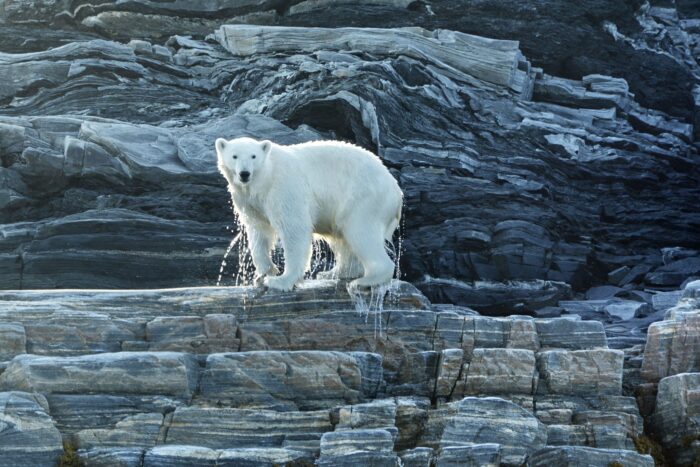
A bear watches from the shore. Photo: Matteo Della Bordella
After the trip, Symon Welfringer says he felt like Ulysses after his Odyssey. In the end, they called the new route Oddisea Borealis (Northern Odyssey).
